Editor’s Note: This post was originally published in July 2019 and was updated for accuracy and comprehensiveness on March 5, 2024.
Customer engagement is a term often thrown around in the worlds of ecommerce and business. What is our customer engagement strategy? How can we optimize customer engagement? How can we ensure our customers are engaged? All are (valid) questions often asked when running an online business.
You probably know more about customer engagement than you think. With social commerce and ads being thrown at you all the time, you experience customer engagement every day. To help demystify this buzzword and what it means for your ecommerce business, we’re going to take a look at how customer engagement is defined, how to measure it, and ways you can use it to acquire new customers and retain the ones you already have.
Customer engagement is an intentional strategy a brand takes to provide something of value to customers.
An effective customer engagement strategy leads to many benefits—customer feedback, user-generated content, increased brand awareness, average order values, repeat sales, and loyalty.
Measure customer engagement with key ecomemrce metrics like guest checkout rates, purchase frequency, average order value, and repeat purchase rate.
Improve your customer engagement with strategies like adding a loyalty program, improving your customer experience, tailoring email and SMS marketing, and more.
Loyalty programs increase customer engagement by incentivizing valuable engagements.
Table of Contents
- What is customer engagement?
- Why is customer engagement important?
- How to calculate customer engagement
- 7 customer engagement strategies you must know
- How a loyalty program can help increase customer engagement
What is customer engagement?
Customer engagement is forming and cultivating a relationship between your business and your customers. For ecommerce brands, customer engagement happens before and after a transaction is made, often in the form of online engagement via your social media channels, content, email marketing, and SMS marketing. It can also happen offline through IRL events, retail locations, word-of-mouth marketing, and direct communication with your (ideal) customers.
How other SaaS companies define customer engagement
Every interaction should have an intention. The interactions that you qualify as an engagement will be just as unique as your business.
Like most definitions, SaaS and B2B companies describe “customer engagement” differently. By looking at different definitions, you’ll actually get a better understanding of all of the intricacies wrapped up in the term and what they all have in common.
This definition starts out with customer engagement being a process that should be planned out with intention. Another key component of customer engagement is giving customers options about where and when to engage with your brand. When you let your customers choose how they’d like to engage with you, you’ll be more likely to uncover the type of interactions that they find valuable.
According to recent survey insights, “70% of consumers say that they’re highly likely to purchase exclusively from brands that understand them and their needs.” By making it easier for customers to engage in ways they find valuable, you’ll strengthen their emotional investment in your brand, leading to brand loyalty.
While the first definition focused on the idea of planning and intention, this one alludes to the fact that there are different levels of customer engagement. Some customers will have a deeper level of engagement than others. For example, a new shopper might engage by following your brand on social media and placing an order. This level of engagement is very different from someone who’s placed 10 orders in the last year and also referred their friends.
After you have acquired a customer, it’s time to engage them. The more emotionally invested a customer is, the stronger their connection with your brand will be and thus begins the customer loyalty loop.
This emotional connection is driven by personalization. A recent study by Zendesk reveals that 60% of customers will become repeat purchasers after a personalized shopping experience.
- Rachel Seet (Marketing Lead at KYDRA)
Both the quality and quantity of customer engagements are equally important. Finding ways to add value to your customer experience can help you drive more meaningful engagements more often. When customers feel like they have just as much to gain from engaging with your brand as you do, you’ll foster a sense of reciprocity that keeps them emotionally connected to your brand.
At the core, every definition shares one thing in common—customer engagement is all about meaningful interactions between your customer and your brand.
Customer engagement vs. customer experience vs. customer satisfaction
If you’ve seen the term customer engagement, you’ve probably also come across customer experience and customer satisfaction. Some brands will use these three terms interchangeably, but they are different concepts that supplement one another.
As we’ve covered, customer engagement refers to the ways you, as a brand, interact with your customers to provide value over time. Customer experience is the journey the customer goes through with your brand. For ecommerce brands, this typically involves all the steps from discovering your brand, making a purchase, and the post-purchase experience. Engaging customers at every step of the customer experience can improve their loyalty.
Where you control customer engagement as a brand, customer experience is subjectively determined by the customer and their perceptions of your brand. Through meaningful customer engagement, you can try to meet and exceed the expectations customers have regarding their customer experience.
Customer engagement is an ongoing process controlled by a brand to provide value for customers, encouraging brand loyalty. Customer experience is the journey a customer goes through with your brand, which forms their perception.
Customer satisfaction is a measurement of how happy a customer is with your brand, product, or service. Both customer engagement and customer experience directly affect customer satisfaction. When you meet, or exceed, a customer’s expectations about their customer experience, customer satisfaction will increase.
Customer engagement is controlled by the brand and delivers value or perceived value to the customer. Customer satisfaction is a measure of whether or not the customer believes the brand met their expectations of the promised value, based on their interactions with the brand.
Meaningfully engage with customers to create a positive customer experience that meets their expectations, resulting in high customer satisfaction.
Customer experience: the journey a customer takes with your brand based on all touchpoints, forming their perception of your brand.
Customer satisfaction: a measure of how happy or unhappy a customer is with your brand, products, or services, based on how you met their expectations.
Why is customer engagement important?
Thanks to platforms like Shopify, BigCommerce, and Wix, it’s easy for anyone to start an ecommerce business. As the competition within ecommerce has grown in some industries and become more crowded, there’s been an overwhelming focus on clicks, conversions, and acquisition costs.

These acquisition strategies alone won’t be enough to grow your business sustainably or retain your customers. Finding ways to engage with your customers before, in between, and after purchases strengthens their connection to your brand, helping you retain the customers you already have while sustainably growing your business.
Gather insightful customer feedback
With AI and first-party customer data, brands are able to engage customers in a hyper-personalized way. Customers are actually expecting and demanding it.
59 percent of customers think businesses should use the data they collect about them to personalize their experience. When measured effectively, your customer engagement campaigns give you a wealth of knowledge to improve your brand loyalty.
Setting clear goals for your customer engagement campaigns, like social media comments, loyalty program redemption rates, or customer satisfaction survey results, gives you insight into what is effective and what’s not. If customers aren’t interested in what you’re posting online, try out some new content. Are rewards redemptions low? Adjust your rewards or redemption levels to make them more motivating. Poor CSAT scores? Consider improving your post-purchase customer experience.
Build trust with user-generated content
One of the most valuable forms of customer engagement is user-generated content (UGC). By definition, user-generated content is anything a user (or customer) creates and posts online. It can be images, videos, reviews, or anything created by a user rather than a brand.
UGC is valuable because customers trust what their peers have to say more than a business. It’s estimated that 84% of people trust online reviews as much as friends.
Using customer engagement strategies can help generate this essential form of social proof. For example, you can run social media campaigns asking customers to post their product photos, like the #AerieReal campaign, which has nearly 400K posts on Instagram.
With a loyalty program, you can incentivize user-generated content by rewarding customers for leaving reviews, with bonus points for photo and video reviews. This provides value to customers through points they can redeem for a reward, but it also provides brand value through building useful UGC.
Improve your brand awareness and identity
An engaged customer base translates into a vocal brand community. When you provide outlets for customers to engage with your brand, you simultaneously build your online presence. This increases brand awareness and exposes you to even more potential customers.
When you create a store, you lay the foundation for a brand with your values, website, products, customer service, social media, etc… In other words, you’re providing platforms to enable customer engagement. Your customers are the ones who actually drive engagement and build your brand identity through how they interact with you at these touchpoints.
Customers who are constantly referring friends, commenting or sharing your social posts, or making repeat purchases are the ones who define your brand. Your customers are your most powerful marketing channel, but only if you engage them.
Boost average order value and repeat sales
Often business owners forget that the entire customer experience involves the research your customer does to land on your site or products, the buying experience, and even after they have received their products. Customer experience is everything in ecommerce, and a good experience is expected. According to insights, “86% of buyers are willing to pay more for a great customer experience.”
Personalized customer engagement can also be the determining factor in someone’s decision to make a purchase. As “49% of buyers have made impulse purchases after receiving a more personalized experience”.
Think about your checkout experience and the opportunities for customer engagement. By leveraging customer data, you can offer relevant products based on the items in the customer’s cart. This type of cross-selling can increase your average order value. Similarly, you can use customer data and segmentation to offer personalized purchase reminders based on the typical buying cycle. Engaging customers at the right time is extremely important, and meeting this expectation will drive repeat purchases.
When a customer recognizes the value of your engagement tactics, they’ll have a positive customer experience, resulting in high customer satisfaction and a repeat purchase.
Engaged customers are more loyal
The ultimate goal of your customer engagement strategy is customer loyalty. When done correctly, customer engagement is one of your most powerful loyalty drivers.
Engaging customers before, during, and after they’ve made a purchase is key to driving repeat purchases and loyalty. This tells customers that you are grateful for their business and you want them to return.
- Carol Wu (VP of Marketing at Maniology)
It’s easy to see that there is a direct correlation between how engaged your customers are and how profitable your business is. There is a benefit to quality customer engagement. The question you need to ask is, “How engaged are my existing customers?”
How to calculate customer engagement
You can’t improve customer engagement if you don’t know how to measure it. There are a number of different ways you can calculate engagement, which is why we’re giving you a head start by highlighting the most important metrics to start with.
Guest checkout rates
What it is: the number of customers who complete a purchase without making an account.
Why it matters: When a customer creates an account, they are more likely to come back to make another purchase.
Purchase frequency (PF)
What it is: how often your customers make a purchase at your store.
Why it matters: when you know how long it takes the average customer to make another purchase, you’ll have a better understanding of how engaged they are.
Average order value (AOV)
What it is: the average amount a customer spends per order when they make a purchase.
Why it matters: this number will tell you how much the average customer spends per purchase when they shop with you. In general, customers who engage in a loyalty program spend 16.5% more than customers who don’t.
Repeat purchase rate (RPR)
What it is: the percentage of customers who’ve made more than one purchase at your store within a specific period of time.
Why it matters: your repeat purchase rate gives a clear snapshot of the effectiveness of your entire retention strategy because it tells you how many customers are engaged enough to make more than one purchase at your store.
Once you have an understanding of your customer engagement baseline, you can start thinking of ways to improve it!
7 customer engagement strategies you must know
When your customers are engaged, they are getting the content they want, finding value in their experience, and feeling a connection to your brand. Simply put, it’s not just responses to your marketing efforts, but continued and meaningful engagement that matters.
With this in mind, customer engagement becomes all about the experiences your brand creates that make your customers want to stick around. Let’s dive into how you can create these meaningful interactions with 7 customer engagement strategies to increase customer loyalty.
Customer loyalty programs
A rewards program is one of the best ways to build customer engagement. It gives your customers an incentive to interact and shop with you by offering them valuable rewards.
Loyalty programs help by creating a switching barrier when customers start earning points with your brand. Shopping with a competitor means giving up a chance to earn and redeem rewards with your brand, leaving unclaimed value on the table.
Rewarding customers for making a purchase with your brand separates you from your competitors because they are getting additional value from shopping with you—beyond your product benefits. To capture the most engagement out of your rewards program, award points for actions like social media interactions, purchases, or birthdays to show your customers how much you value their engagement.
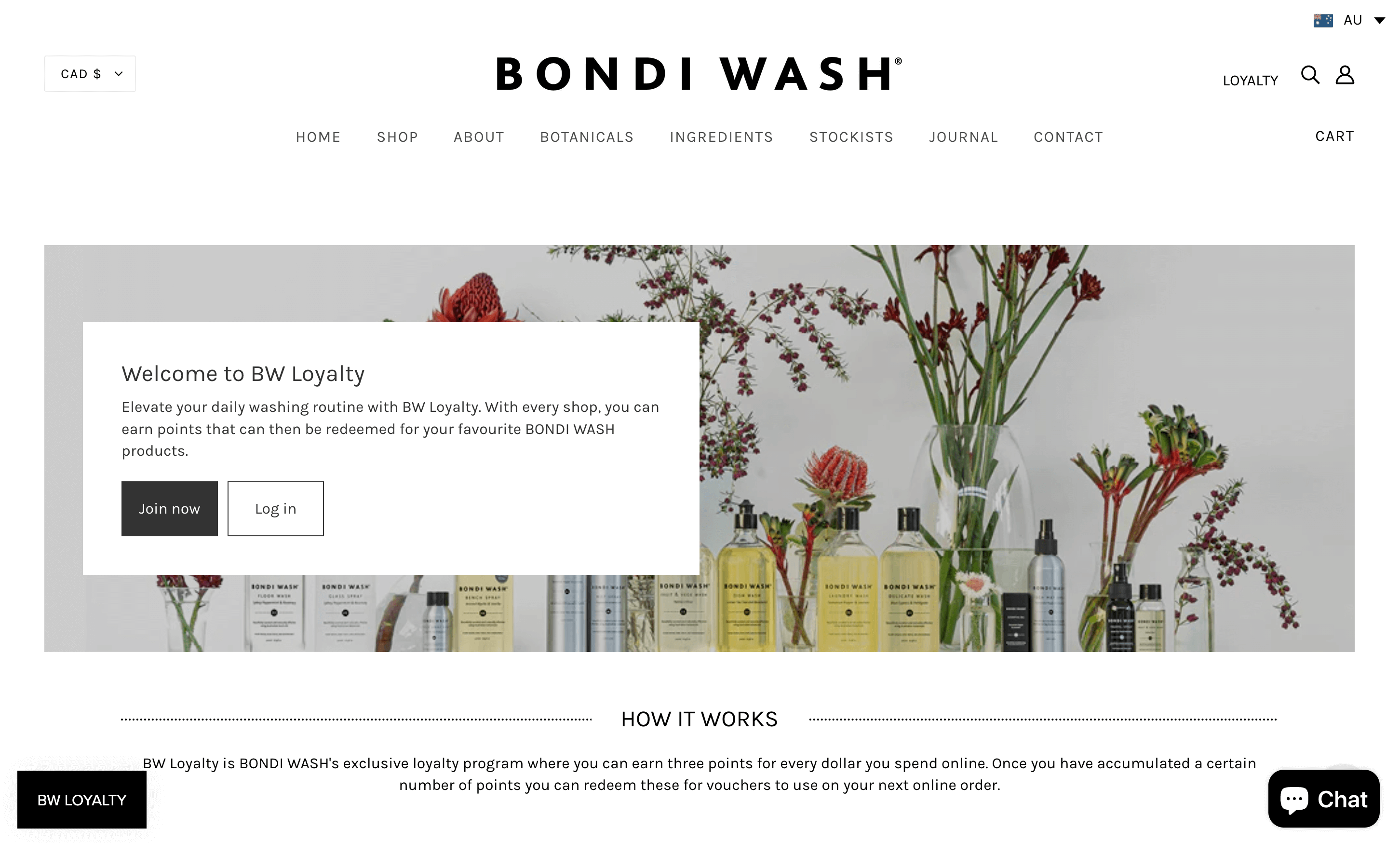
Referrals are another great way to keep your customers engaged. Once they’ve already shopped with you and had a great customer experience, chances are they’re going to want to share it with others. So why not reward them for this? Customer referrals are the perfect way to allow your engaged customers to do the work for you.
Reward programs motivate customers to keep engaging with your brand leading to your ultimate goal—customer loyalty.

User-generated content
In today’s mobile-first world, social media needs to be a part of your customer engagement strategy. This is where your customers are spending a lot of their time, so you should put considerable effort into connecting with them here.

One of the most important things you should be doing on social media is looking out for customer posts that highlight your products. When customers take time out of their day to share your brand, it’s the least you can do to return the favor. Reposting customer photos on your own social media accounts or website allows you to leverage this type of user-generated content to build authenticity and trust for your brand.
Not only does leveraging user-generated content help your brand engagement; it excites your customers. Offering rewards for these types of actions, such as photo reviews or social media interactions are a few ways to motivate them to engage in this type of behavior.
To your best customers, the best incentive is the chance to be acknowledged by the brand they love.
Customer feedback
Nobody knows what your will meet your customers’ needs better than…your customers. Engage your community by asking for their opinions and feedback. Everyone feels important when asked for their opinion, and your customers are the most important people to you, so you should treat them that way!
Rewarding your customers for things like written reviews or testimonials benefits you by building an authentic brand. Several customers consider this type of social proof extremely important when making purchases online since they can’t physically touch or feel the products. It’s this level of dedication to your customers’ feedback that makes them feel truly connected and engaged with your brand.
Skincare brand Blume recently engaged its community in a very impactful way. Blume sent a survey to its community surrounding acne and mental health. The team used these results to develop a new product, an acne cleanser. Community members not only received early access to purchase the product at a discounted price, but they also got to see the direct result of their engagement come to life.
Aside from asking for reviews, you can gather customer feedback through both quantitative and qualitative methods. Try engaging with customers through post-purchase surveys, net promoter score surveys, social media polls or question boxes, social listening, online quizzes, live chat, and more.
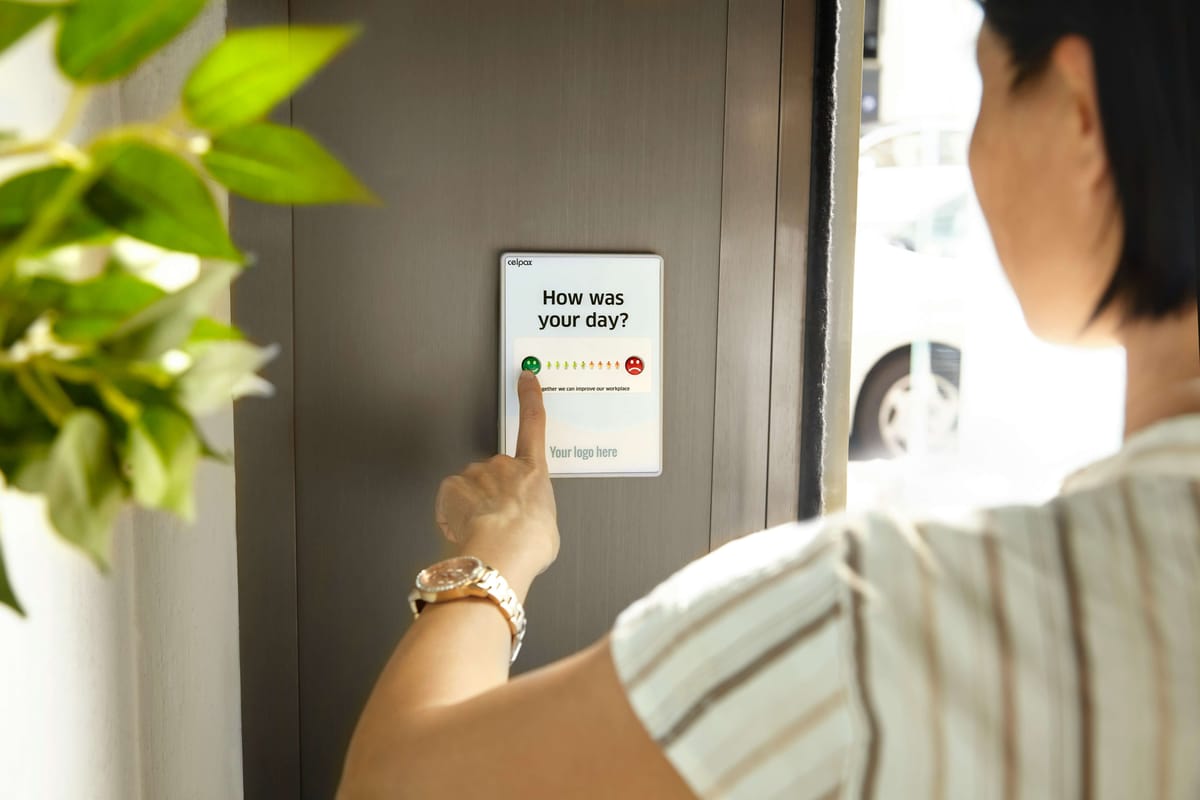
Email and SMS marketing
Email and SMS marketing are some of the most effective engagement strategies because they’re hyper-personalized, direct, and easy to maintain. And they’re a key revenue driver.
The purpose of your email or SMS message needs to be clear to create customer engagement. There are several types of emails you can send to encourage loyalty, like point reminder emails, personalized product recommendations, or abandoned cart emails.
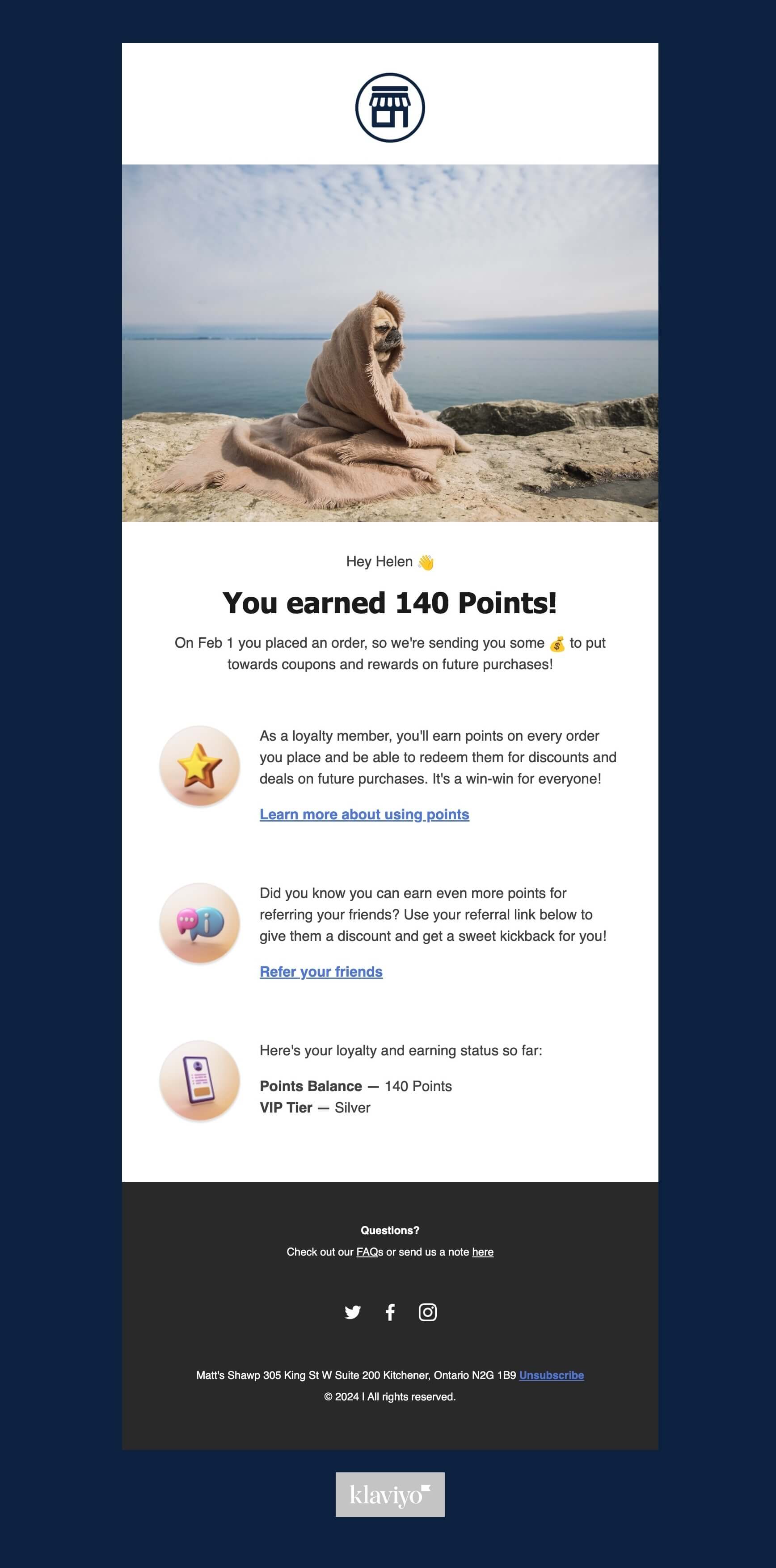
The key to success with all of these is to make them interactive, with a clear call to action. You want to deliver an email that your customers are actually excited to open and read.
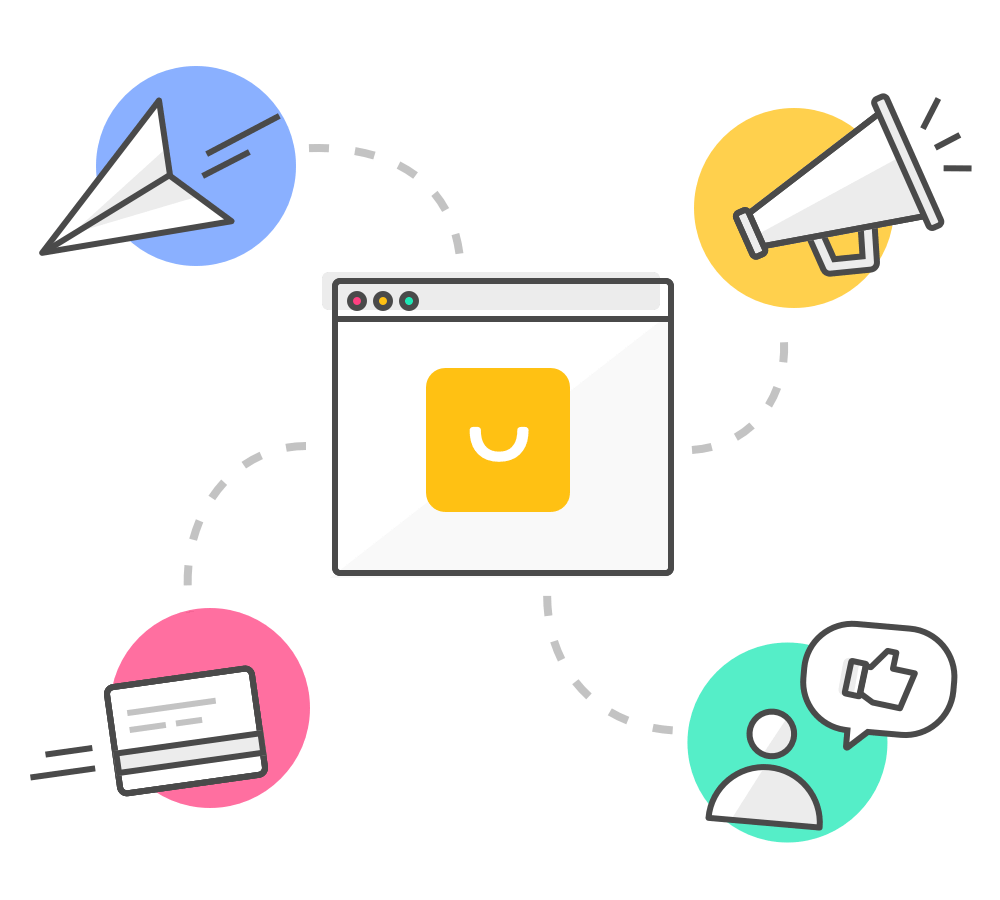
Value-added marketing
Extra value is something that customers crave with every interaction. Value-add marketing is more meaningful than advertisements because it’s more cost-effective and builds better relationships. Value-add marketing can serve several purposes, from educating your customers to providing advice or entertainment. It allows you to give your customers the information they actually want by delivering content like blogs, videos, podcasts, downloads, webinars, and more.
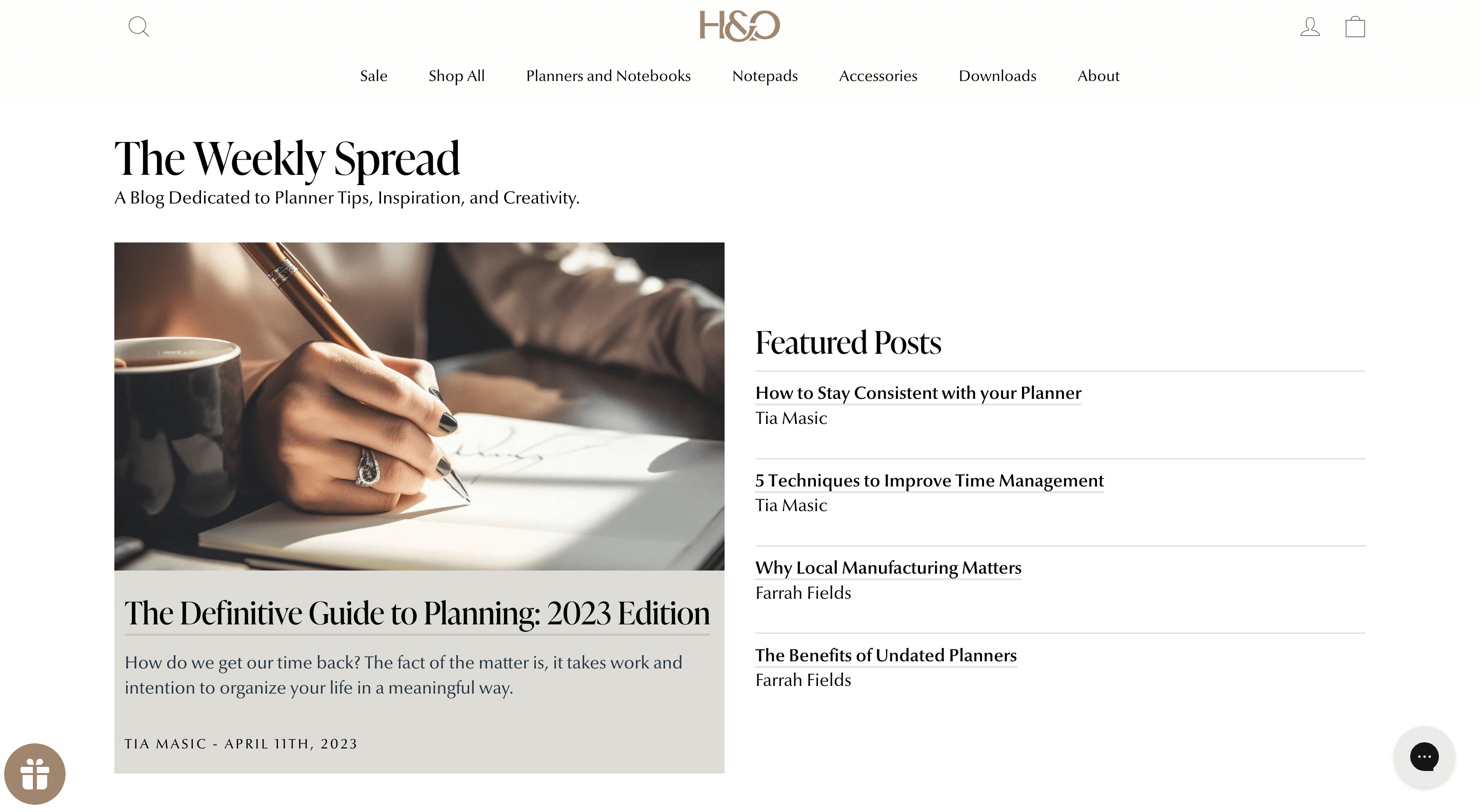
For some customers, this type of content is what keeps them coming back, and for others, it might be how they discover you in the first place. Either way, there’s no doubt that value-add marketing can separate a brand a customer likes from a brand they love.
Personalized customer experience
It’s not your products or prices that build relationships with customers, it’s your brand that does. This can start with a strong customer experience that resonates with your customers. Having a consistent brand experience across every channel you use, from your website to your social media to your live chat, is so important.
Once you identify your core values, you need to make sure that everything you do also communicates these values. This is a combination of everything, including the language you use in your copy, the colors in your logo, and your website design.
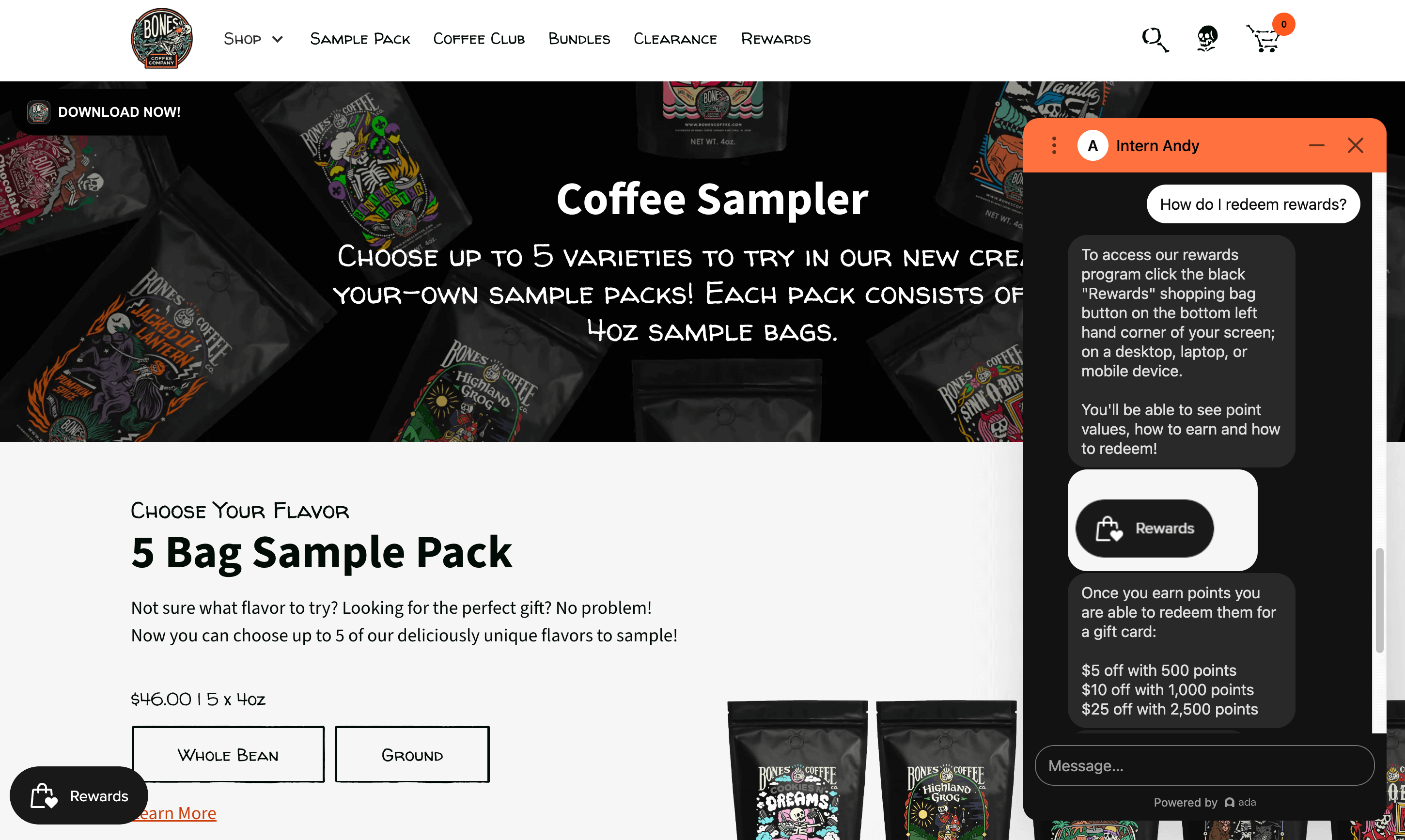
You can personalize your brand experience through Shopify app integrations for all of your marketing actions. By using Gorgias, like Bones Coffee, for live chat customer service, brands can power their customer service team with live customer data at their fingertips.
You can also use Klaviyo for your email and SMS marketing to create email segments and custom flows based on specific customer events. Taking advantage of a wide network of Shopify app integrations allows you to automate and personalize your customer experience at the same time.
With an ecommerce store, you miss out on the ability to connect with your customers face-to-face, so you have to let your customer experience humanize your brand.
Gamification
No matter how old we get, everybody loves to play a good game once in a while. Adding gamification to your loyalty program is a great way to make the customer experience fun!
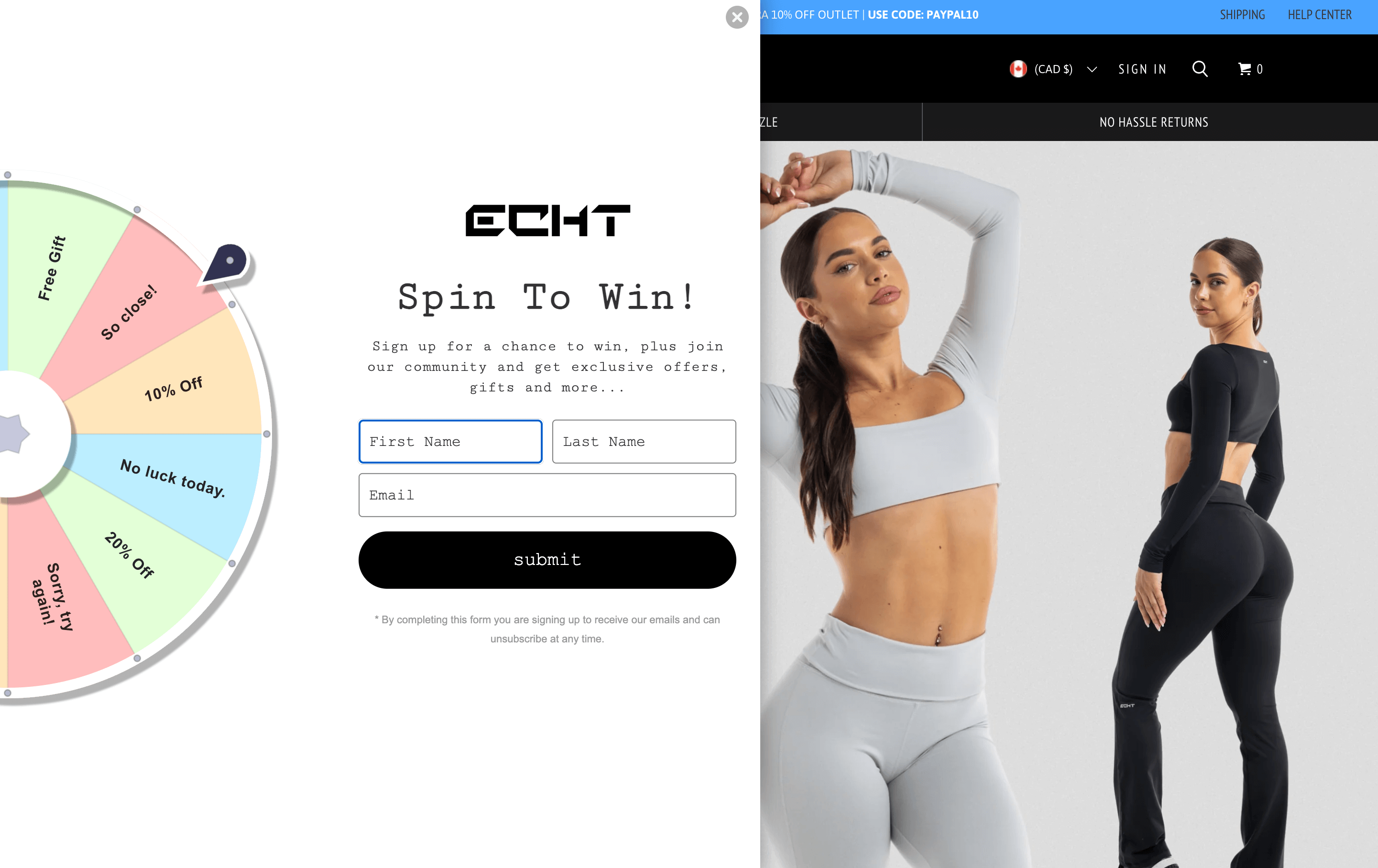
With the average worker receiving 121 emails per day, it can be hard to stand out. But a customer is way more likely to remember the brand that made them spin a wheel to receive their discount, over the one that simply wrote it in black and white.
These fun experiences are unique in your customers’ minds and will cause them to share your brand with other people.
How a loyalty program can help increase customer engagement
The more engaged your customers are, the more emotionally invested they are in your brand. It’s this emotional investment that makes them less likely to shop with a competitor and what strongly connects customer engagement to customer loyalty. It’s estimated that more than 90% of companies across ecommerce industries have some type of loyalty program offered to their customers.
Customers don’t want to feel like they’re missing out on something. The key to customer retention is to add value to every engagement that a customer has with your brand. They’ll be less likely to shop with a competitor since they’ll earn additional value from your store.
🚨 Acquiring new customers is important, but retaining current ones is crucial for the success of any eCommerce business.
— Corin Romkey (@CorinRomkey) January 17, 2023
Maintaining customer engagement and loyalty to your brand is essential.
Loyalty program members not only make purchases more often, but they also have an average order value that is 16% higher than their non-member counterparts which makes them a critical part of your growth strategy. According to Shopify, “It’s estimated that as many as 84% of consumers say they’re more apt to stick with a brand that offers a loyalty program.”
Here are four simple ways you can use your loyalty program to drive customer engagement.
Award points when a customer makes a purchase
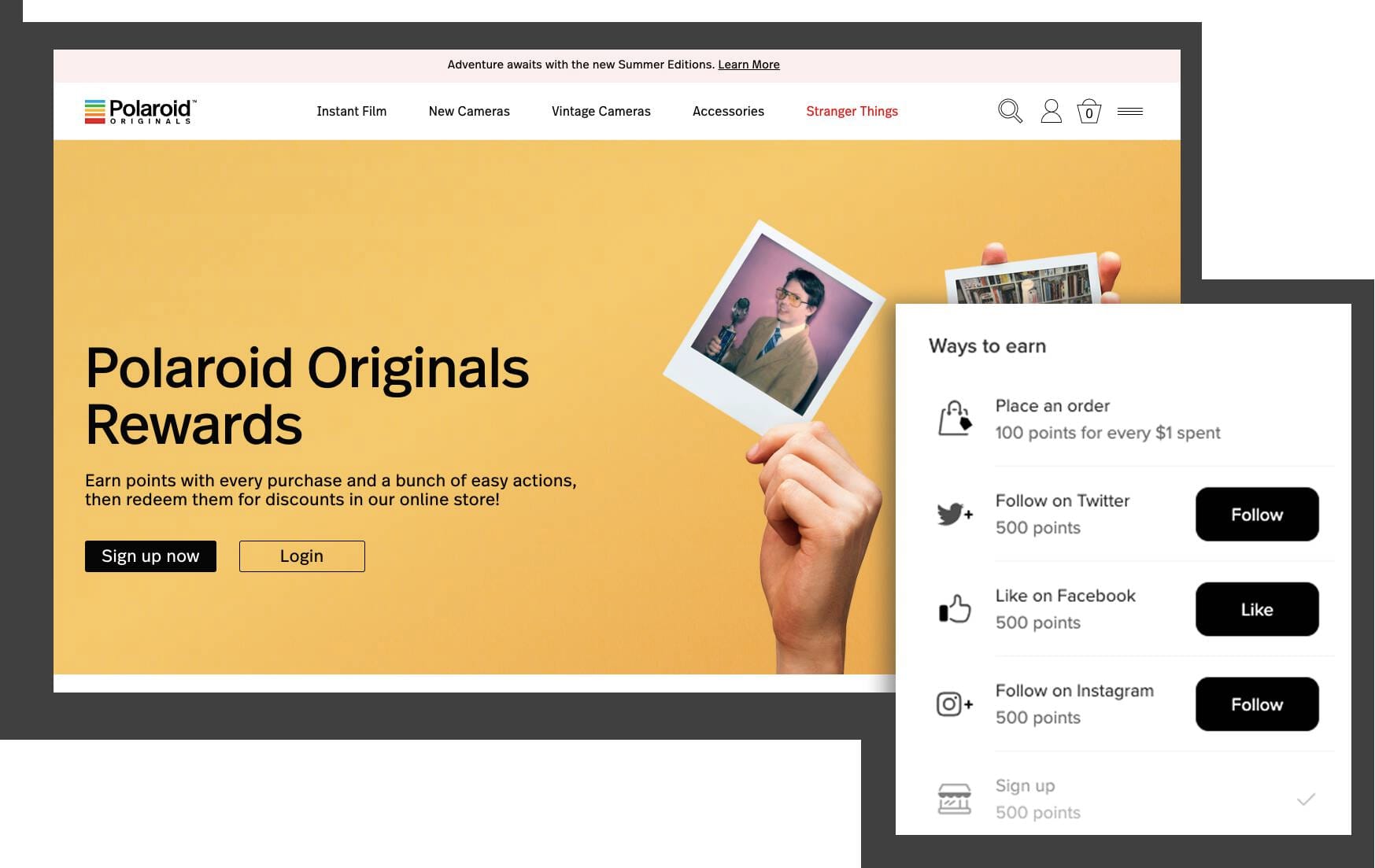
Showing your customers that you appreciate their investment in your brand can be as simple as awarding them points each time they place an order. Polaroid Originals adds value to every order its customers place, making each of them more likely to return to make another order in the future.
By showing its customers they have just as much to gain from each purchase as they do, Polaroid has fostered feelings of reciprocity that will give its customers every reason to order from them again.
Encourage your customers to connect with you on social
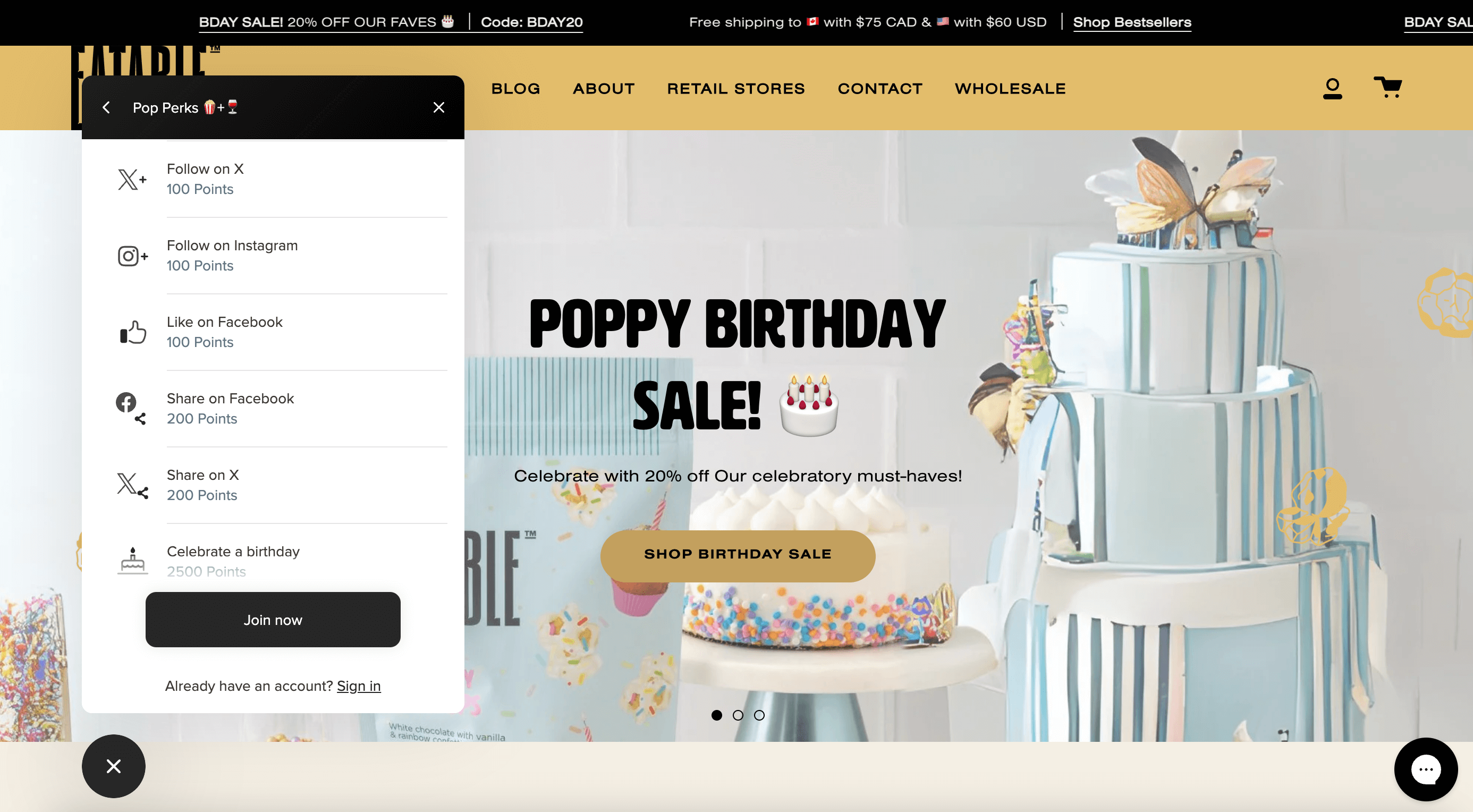
Driving engagement doesn’t necessarily have to focus solely on more purchases. Simple actions like customers following your brand on social media or sharing your store with friends on Instagram can also go a long way in keeping them engaged over time. Gourmet popcorn brand, EATABLE adds tangible value for every new social follower with reward points. This reward makes each new follower more likely to find other ways to engage and gives EATABLE another way to stay engaged with its customers over time.
- Charlene Li (CEO of EATABLE)
Personalize the experience
Your loyalty program should be part of the customer experience and engagement through all touchpoints. Personalized customer engagement can be the determining factor in someone’s decision to make a purchase. It can also be the determining factor in whether or not a customer will return for a repeat purchase.
Incorporate other ways to reach customers on your loyalty program, including SMS marketing, email campaigns, pop-up events, and in-store rewards.
Retargeting flows for email & SMS are key for businesses to increase customer engagement & conversion rates.
— Jacob Thomas (@FitDadJake) January 25, 2023
Personalized campaigns drive sales & boost loyalty. Reach customers at the right time for better ROI on marketing efforts.
Encourage your best customers to share your brand with referrals

Driving engagement also doesn’t have to be solely between your customers and your brand, it can also be between customers. Empowering your best customers to easily share your brand with their friends and family can not only help you acquire a new one but also engage the customers you have.
Apparel company Only Human offers a referral program where customers can refer anyone. The new customer receives $10 off their first order of $40 or more, while the customer giving the referral receives $10 off their order. Referrals simultaneously add value to the friend that’s been referred to their brand and the customer that referred their friend. It’s this value that will make both customers more likely to re-engage again in the future.
Keep your customers engaged long after they confirm their order
Gone are the days when focusing on the number of customers you acquire was enough. If your customers are making a purchase once and then never even thinking about you again, there’s a huge problem.
Your goal should be to cultivate a community of customers who are excited to be shopping with you and counting down the seconds until they can interact with you again. There are several different engagement-building strategies that will help you get here and build your loyal customer base.
The key is determining which strategy will work best for you based on your customers.










